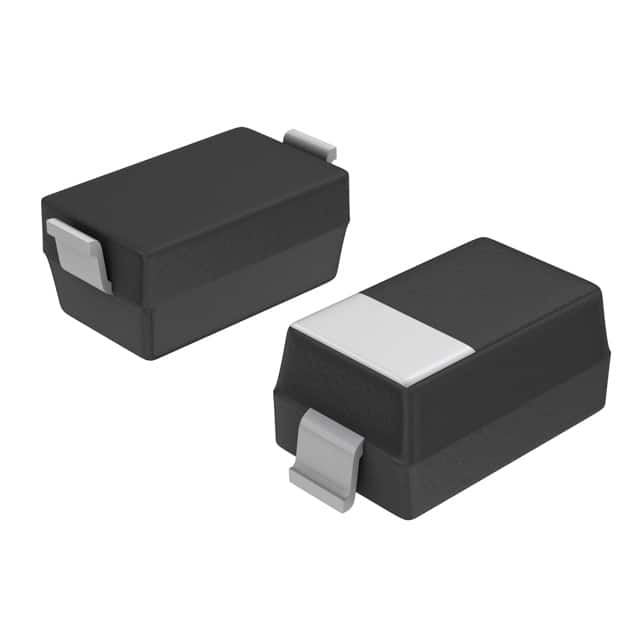Viz Specifikace pro podrobnosti o produktu.

MMSD701T1 Product Overview
Introduction
The MMSD701T1 is a semiconductor device belonging to the category of Schottky diodes. This entry provides an in-depth overview of the MMSD701T1, including its basic information, specifications, pin configuration, functional features, advantages and disadvantages, working principles, application field plans, and alternative models.
Basic Information Overview
- Category: Semiconductor device/Schottky diode
- Use: Rectification and voltage clamping
- Characteristics: Low forward voltage drop, fast switching speed
- Package: SOT-23
- Essence: High-frequency rectification
- Packaging/Quantity: Tape & Reel, 3000 units per reel
Specifications
- Forward Voltage Drop (VF): 0.35V @ 1A
- Reverse Voltage (VR): 70V
- Average Rectified Current (IO): 200mA
- Operating Temperature Range: -65°C to +125°C
Detailed Pin Configuration
The MMSD701T1 has three pins: 1. Pin 1: Anode 2. Pin 2: Cathode 3. Pin 3: Not connected
Functional Features
- Fast switching speed for high-frequency applications
- Low forward voltage drop for efficient energy conversion
- Small form factor for space-constrained designs
Advantages and Disadvantages
Advantages
- High-speed switching capability
- Low power dissipation
- Compact package size
Disadvantages
- Limited reverse voltage tolerance
- Sensitivity to overvoltage conditions
Working Principles
The MMSD701T1 operates based on the Schottky barrier principle, where the metal-semiconductor junction allows for faster switching and lower forward voltage drop compared to conventional diodes.
Detailed Application Field Plans
The MMSD701T1 is suitable for various applications, including: - Switching power supplies - Voltage clamping circuits - High-frequency rectification in RF circuits - Overvoltage protection in electronic systems
Detailed and Complete Alternative Models
Some alternative models to the MMSD701T1 include: - 1N5817: Similar forward voltage drop and reverse voltage rating - BAT54S: Dual Schottky diode with comparable characteristics - SS14: General-purpose Schottky diode with higher current rating
In conclusion, the MMSD701T1 is a versatile semiconductor device with fast switching speed and low forward voltage drop, making it suitable for various high-frequency applications and voltage clamping circuits.
Word count: 324
Seznam 10 běžných otázek a odpovědí souvisejících s aplikací MMSD701T1 v technických řešeních
What is MMSD701T1?
- MMSD701T1 is a type of sensor module used in technical solutions for measuring and monitoring various environmental parameters such as temperature, humidity, and air quality.
How does MMSD701T1 work?
- The MMSD701T1 sensor module uses advanced technology to detect and measure specific environmental parameters. It typically includes sensors, signal processing circuitry, and communication interfaces to transmit data to a microcontroller or computer.
What environmental parameters can MMSD701T1 measure?
- MMSD701T1 can measure parameters such as temperature, humidity, air pressure, air quality (e.g., volatile organic compounds), and ambient light levels.
How accurate is the MMSD701T1 sensor module?
- The accuracy of the MMSD701T1 sensor module depends on various factors such as calibration, environmental conditions, and the specific parameter being measured. Generally, it provides reliable and precise measurements within its specified range.
Can MMSD701T1 be integrated with microcontrollers or IoT devices?
- Yes, MMSD701T1 is designed to be easily integrated with microcontrollers, single-board computers, and IoT platforms through standard communication interfaces such as I2C, SPI, or UART.
What are the typical applications of MMSD701T1 in technical solutions?
- MMSD701T1 is commonly used in applications such as environmental monitoring systems, smart home automation, HVAC control, industrial process monitoring, and weather stations.
Does MMSD701T1 require special calibration or maintenance?
- MMSD701T1 may require periodic calibration to ensure accurate measurements, especially in critical applications. Maintenance requirements are generally minimal, but it's important to follow the manufacturer's guidelines.
Is MMSD701T1 suitable for outdoor use?
- Depending on the specific model and its environmental ratings, some versions of MMSD701T1 are designed for outdoor use and can withstand varying weather conditions.
Can MMSD701T1 be used in conjunction with other sensors or modules?
- Yes, MMSD701T1 can be integrated with other sensors and modules to create comprehensive monitoring and control systems for diverse technical solutions.
Where can I find technical documentation and support for MMSD701T1?
- Technical documentation, datasheets, and support resources for MMSD701T1 are typically available from the manufacturer's website, distributor channels, and online communities dedicated to sensor technology and applications.

